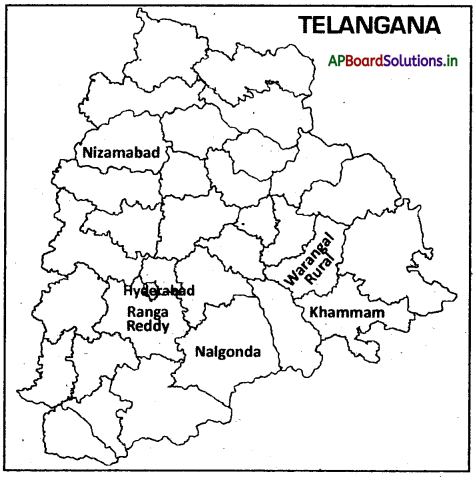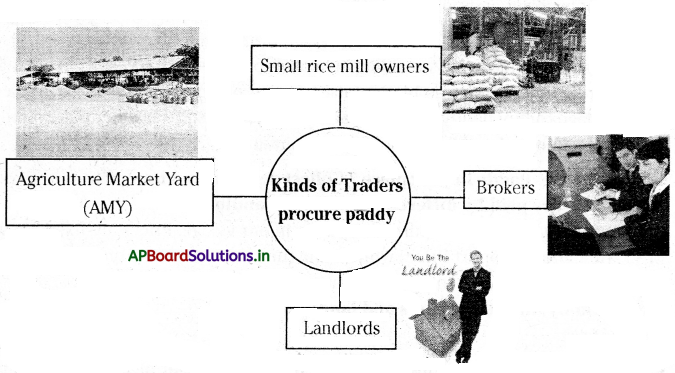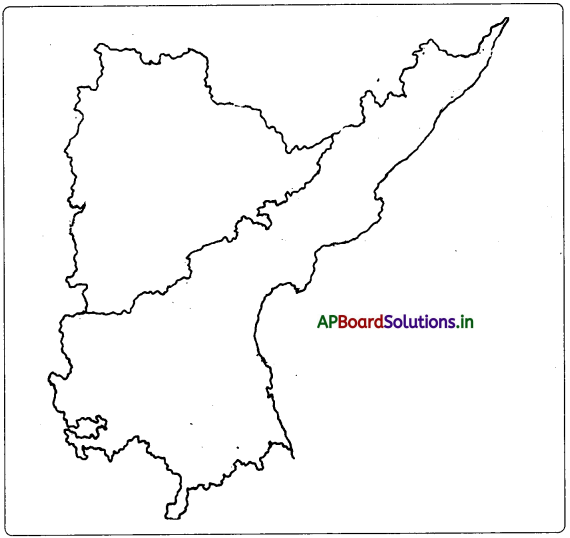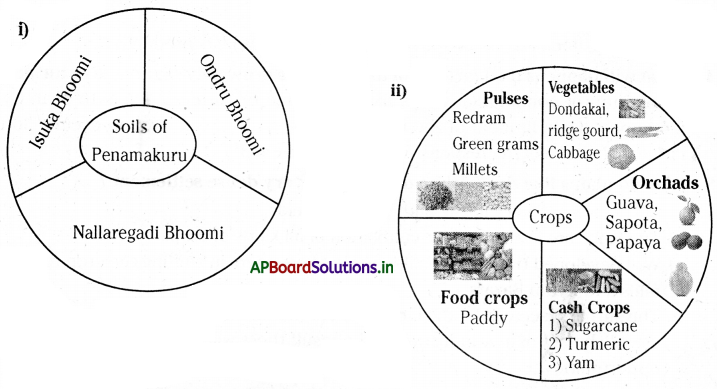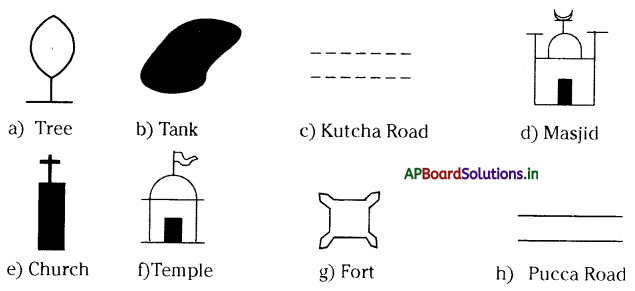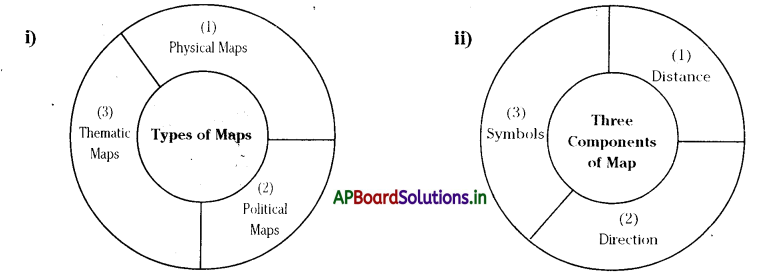Telangana SCERT TS 6th Class Social Study Material Pdf 10th Lesson – Emergence of Kingdoms and Republics Textbook Questions and Answers.
Emergence of Kingdoms and Republics – The Earliest People – TS 6th Class Social 10th Lesson Questions and Answers Telangana
Question 1.
What do you mean by Gana ? How were they different from the kingdoms ruled by kings ?
Answer:
Gana is used for a group that has many members.The Vajji Mahajanapada was to the North of Magadha and it had a Gana form of government. In a Gana there is no single ruler but a group of rulers. Sometimes even thousands of men ruled together and each of them called themselves a ‘Raja’. They performed rituals, met and decided upon issues of common interest in assemblies through discussion and debate.
However, women, slaves and wage workers could not participate in these assemblies. Buddha and Mahavira belonged to ganas and became famous teachers respected all in the Mahajanapadas. Even though the kings tried to conquer the ganas they remained active for more than 1500 years.
![]()
Question 2.
Compare the ganas with Gond Panch – what similarities and differences do you see between them ?
| a) Similarities | |
| Gond Panch | Gana |
| 1) The village headman derive their authority from the village ‘Panch’ or the council of adult male house holders. | a) Similarities |
| 2) This council has the last word in matters concerning the village as a whole. | 1) Gana is used for a group that has many members. |
| 3) The headman is no more than its chairman. The village panch in a sense represents the Gond Society as a whole. | 2) In a Gana there is no single ruler but a group of rulers. |
| 4) Women have no voice in the council. | 3) Sometimes even thousands of men ruled together and each of them called themselves a rajAnswer: |
| 1) The village headman derive their authority from the village ‘Panch’ or the council of adult male house holders. | 4) Women, slaves and wage workers could not participate in Assemblies. |
| b) Differences | |
| Gond Panch | Gana |
| 1) In Gond Panch headman is no more than its chairman. The village Panch in a sense represents the Gond Society as a whole. | 1) Here thousands of men ruled together and each of them called themselves a Raja |
| 2) The Panch can fix the dates of major festivals, allow marriages or divorces, set down norms for marriages or death rites and settle disputes. | 2) They performed rituals, met and decided upon issues of common interest in Assemblies through discussion and debate. |
Question 3.
Can you point out the difference between the way villages are managed today and in the time of Mahajanapadas ?
Answer:
- There are some differences between the way villages are managed today and in the time of Mahajanapadas.
- Now villages have elected representatives but then the largest land owner became the headman of the village%
- Now government servants collect taxes in villages are remit to the government account, but then headman collected taxes and paid to the king.
- Farmers in villages now hire agricultural labourers to work in their fields, but then land-owners employed slaves (dasas) and bhrutakas.
![]()
Question 4.
Find out how the crafts persons are taxed by the government today. Was it the same in the times of Mahajanapadas ?
Answer:
- Crafts persons were very low taxed or exempted of the tax by the government now.
- In mahajanapadas crafts persons are to pay tax often by working free of charge for the king for one day every month.
- If anyone refuses to pay tax at that time they could be punished by the soldiers of the king.
- Now government may collect taxes with fine at a later time.
- King used his officers and army in the collection of taxes.
- Government servants now collect taxes and remit to the government.
Question 5.
Read the para five in page 174 (87) ‘In most villages ‘ and write your comment.
Answer:
The villages had rich mineral resources and were blessed with many crafts persons. The crafts persons worked successfully to meet the needs of the villagers. In return they received grains. This is an example for self sufficiency and Barter system of exchange.
Question 6.
Locate the 16 Janapadas on the map of India (Refer to the map 1 given in page 172 (86).
Img-1
I. Conceptual understandings
Question 1.
Why did the kings of Mahajanapadas need armies ?
Answer:
Most of the Mahajanapadas were ruled by kings. These kings need armies because :
- The people followed their orders.
- No other king would attack their kingdom.
- The strong fortresses were built by the armies.
- The people who refused to pay taxes were punished by the armies.
Question 2.
What are the differences between the Gond Patla and the king of Mahajanapada in terms of their income and expenditure ?
Answer:
| Gond Patla | The king of Mahajanapadas |
| 1. The Gond Patla too had to occasionally defend the village from outsider. At such times all the villagers would get together and fight on behalf of the village. | The kings of Mahajanapadas were different from such tribal headman or chiefs. The king had an army. These officers and army men bound to follow his orders. |
| 2. He met the expenses of entertaining guests and holding festivals from the extra income. He got from the one day labour of the villagers on his fields. That income was far too little for a tribal headman to become rich or powerful. | The kings collected taxes from the people. They had officers who would collect taxes from the grihapatis. the craft persons and traders. If anyone refused to pay taxes they could be punished by the soldiers of the king. |
| 3. The ordinary people Of the tribe would only support the headman or agree to his commands if they were convinced that it was in the interest of all. | The king could also ensure that all his commands for the common people were obeyed by them. |
Question 3.
What was Bhaga ? Does the government of our times take the produce of farmers in similar way ?
Answer:
The kings began to collect regular taxes from the grihapatis who cultivated the land. The grihapatis had to divide their crops into six equal parts and give one part to the king. This was called BhagAnswer: The government of our times does not take the produce of farmers. It collects minimum tax as per the quantity of produce of the farmers.
![]()
Question 4.
Name the persons who paid taxes to the Raja (King) of the Mahajanapada ?
Answer:
The following are all those persons who paid taxes to the king of Mahajanapadas.
- Grihapatis : They had to divide their crops into six equal parts and give one part to the king.
- Herders : They give the animal produce to the king in the form of tax.
- Craft persons : They also had to pay taxes often by working free of charge for the king for a day every month.
- Hunters and gatherers : They had to bring forest produce like hides, wood, etc.
Question 1.
How do we know about the Mahajanapadas?
Answer:
We get to know much about these villages and towns from two kinds of sources – from archaeological excavations in different places and also from the books composed during this period. Archaeologists have excavated hundreds of sites in the Ganges Valley and have tried to know about the lives of people of those days. The books during that period were mostly composed by Brahmins, Buddhists and Jaina monks.
Even though they were religious books, they tell us about the towns and villages and also about the kings and rulers of those times. Some important archaeological sites of the time of Mahajanapadas: Delhi, Atran- jikhera, Kausambi (near Allahabad) Patna, Ayodhya, Rajgir, etc. Some important books written during this period : Upanishads, Dharma Sutras, Digha Nikaya, Majjhima Nikaya, Heredotus’ History and Strabo etc.
Question 2.
Describe the relationship between Grihapatis and Craft persons of the village.
Answer:
In most villages there were craft persons like blacksmiths who made tools necessary for agriculture (like ploughshares, sickles, axes, arrows, etc), potters who made pots for cooking and storing grains, carpenters who made carts, ploughs, furniture, etc., and weavers who wove cloth for the villagers. Probably the grihapatis gave them grains in return for their products. These craft products were necessary for agriculture, but the grihapatis may not have had the time or skill to make them.
![]()
Question 3.
How do you think the king maftaged to get the wealth needed for all this ?
Answer:
- Many kings wanted to be more powerful and wealthy. They could do this in two ways.
- Firstly, by increasing the taxes on their subjects and secondly, by conquering neighbouring kingdoms.
- The kings began to collect regular taxes from the grihapatis who cultivated the land.
- The grihapatis had to divide their crops into six equal parts and give one part to the king.
- This was called bhagAnswer: Craft persons also had to pay taxes, often by working free of charge for the king for a day every month.
- Herders of cattle and sheep too had to give the animal produce to the king in the form of tax.
- Traders were also made to pay taxes on the goods they sold.
- Hunters and gatherers in the nearby forest areas too had to bring forest produce. like hides, wood etc. In this way the kings had a variety of goods which they obtained as taxes. During this period the use of coins had just begun. Some of the taxes were probably in the form of coins.
Question 4.
Why do you think they agreed to pay the taxes ? Do you think they benefited in any way from the new arrangements ?
Answer:
Most of the Mahajanapadas were ruled by kings. These kings had an army of their own to ensure that people followed their orders and no other king would attack their kingdom. All these required huge expenditure. The soldiers and their families had to be provided for, the brick makers who made lakhs, of bricks had to be paid for, thousands of men and women who worked to construct these public, buildings had to be paid wages. The king could also ensure that all his commands for the common people were obeyed by them.
Question 5.
Why were the kings of Mahajanapadas keen to increase craft production and trade?
Answer:
Historians feel that these kings would have persuaded the farmers to grow more crops and adopt better methods of cultivation and irrigation so that production would increase and they can get more taxes.
a) Traders : Similarly they may have encouraged traders of their kingdoms to trade more in distant places. The kings also wanted the village headmen to collect taxes on their behalf. This may have helped many headmen to increase their power and resources in the villages.
b) Craft Production : In most villages there were craft persons like’blacksmiths who made tools necessary for agriculture (plough shares, sickles, axes, arrows etc), potters who made pots for cooking and storing grains, carpenters who made carts, ploughs, furniture, etc., and weavers who wove cloth for the villagers. These craft products were encouraged by king for imposing taxes.
![]()
Question 6.
How did the headmen of the villages benefit from the imposition of taxes by the kings ?
Answer:
Usually the largest land owner became the headman of the village. He was the leader of the village like the Gond Patla and he was also used by the king to collect taxes from other villages.
He also acted as the judge and sometimes as a policeman to maintain law and order in the village. The kings also wanted the village headmen to collect taxes on their behalf. This may have helped headmen to increase their power and resources in the villages.
III. Information Skills
1. Read the following passage.
Villages in the Times of Mahajanapadas
We learn from the books of those times that agriculture was managed by landowners called Grihapatis or Gahapatis, who usually worked along with their family members on the fields. But they also employed ‘dasas’ or slaves (those who were surrendered and made to serve ) and workers ‘bhartukas’ or who worked on their fields and homes in return for wages.
Some wealthy grihapatis had more land and slaves to work for them. Usually the largest landowner became the headman of the village. He was the leader of the village like the Gond Patla and he was also used by the king to collect taxes from other villagers. He also acted as the judge and sometimes as a policeman to maintain law and order in the village.
Answer the following questions:
1) Who were Grihapatis ?
Answer:
The agriculture was managed by landowners called Grihapatis or Gahapatis.
2) Who were ‘dasas’ ?
Answer:
Grihapatis employed dasas or slaves (the who were surrendered and made to serve.)
3) What do they call workers at that time ?
Answer:
The workers were called bhrutakas or who worked on their fields and homes in return for wages. •
4) Who became the headman ?
Answer:
Usually the largest landowner became the headman of the village. He was the leader of the village.
5) What was the duty of headman ?
Answer:
He had to collect taxes from the other villagers. He also acted as judge and sometimes as a policeman to maintain law and order in the village.
IV. Reflection on Contemporary Issues and Questioning
Question 1.
What do you mean by Janapada ? How is this different from Mahajanapadas ?
Answer:
1. Janapadas: The word Janapada literally means the land where the Jana set its foot and settled down. ,
Initially the people of different tribes.settled down to practice agriculture in convenient parts of the valley.
2. Mahajanapadas : People began settling down along these rivers in large numbers some 4000 years ago. They cut down the forests with the help of tools made of stone, copper, bronze and iron for clearing of forests, settlements and tilled the land to grow paddy and other crops. Large villages and towns developed in these parts and these were inhabited by many people – probably belonging to many different tribes. Large groups of such villages and towns were called Mahajanapadas or big Janapadas.
![]()
Question 2.
How would they decide if a site was a village or a town ?
Answer:
Archaeologists have excavated hundreds of sites in the Ganges Valley and have tried to know about the lives of people of those days. The books during that period were mostly composed by the followers of Vedic traditions Brahmins, Buddhists and Jain monks.
Even though they are religious books, they tell us a lot about the towns and villages and also about the kings and rulers of those times. Some important archaeological sites of the time of Mahajanapadas : Delhi, Atranjikhera, Kausambi (near Allahabad), Patna, Ayodhya, Rajgir, etc.
VI. Appreciation and Sensitivity
Question 1.
In what way do you think the kings of Magadha used the natural wealth of the region to build a powerful kingdom ?
Answer:
The rivers made the land very fertile and the grihapatis could irrigate their lands easily. The rivers were also used for transporting goods and armies. Parts of the Magadha were forested. Elephants were captured from there and trained for fighting in the armies. Wood from the forests was used for building fortresses and palaces and chariots. In the southern parts of Magadha there were iron ore deposits which could be used for making weapons etc.
All this enabled Magadha to emerge as a very powerful kingdom. Bimbisara and his son Ajatasalru were early kings who built the power of MagadhAnswer: Mahapadma Nanda was another powerful ruler of MagadhAnswer: All these kings used their armies to conquer other kingdoms. During the time of Mahapadma Nanda the kingdom extended from the northwest part of India to OdishAnswer: Thus Magadha used the natural wealth of the region to build a powerful kingdom.
![]()
Question 2.
Write a story about a slave of a Grihapati who travelled from his village to the city of Pataliputra with his master.
Answer:
Once a man was sold to a grihapati of Magadha as slave. The grihapati took him to his Mahajanapada from ‘Asmaka’. The slave was tied with iron chains. It was very difficult to run behind his owner’s horse with chains. After a few days the slave was unchained. He had to do all the personal works for his master. But one day he memorized his family members, and tried to escape. But the grihapati caught him. Then the slave was tied to his horse. He was wounded totally in two days. He reached Magadha without any treatment. There he spent his life time alone with that grihapati.
TS 6th Class Social 10th Lesson Notes – Emergence of Kingdoms and Republics
- Kingdom : A country ruled by a king is called kingdom.
- Republic : A country that is governed by a President and politicians elected by the people and where there is no king or queen.
- Janapada : Initially the people of different tribes settled down to practice agriculture in convenient parts of the valley. These tribes were called ‘Jana’ in Sanskrit and the place where they settled was called JanapadAnswer:
- Mahajanapada : Large groups of such villages and towns were called Maha Janapadas or big JanapadAnswer:
- Dasas : Land owners employed ‘dasas’ or slaves who were probably captured in wars and sold to farmers.
- Bhartukas : The workers “Bhartukas’ who worked on their fields and homes in return for wages.
- Grihapatis : The agriculture was managed by land owners called Grihapatis or Gahapatis who worked along with their family members on the fields.
- Gangetic Plain : The plain is called Gangetic Valley (as the Ganga and Yamuna rivers flow between the Himalayan Mountains and the hills of the Deccan Plateau). As this plain receives very high rainfall, it is very fertile.


